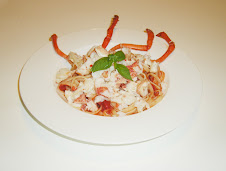Yesterday, I visited an old friend of mine in San Pedro. He is old-world food purveyor from Sardinia. We talked about Italian food and flavor. We walked through his garden and tasted tiny yellow cherry tomatoes, fava beans, parsley, and Salvia (also known as Bergarten Sage, a velvety gray green leaf picked from a billowing evergreen bush). A member of the mint family, Salvia is a common Mediterranean kitchen herb that is often overlooked here in the American kitchen. Dino’s sage was brought over from Italy, as seed.
Salvia (which means “to save” or “to heal”) has an earthy warm aroma and a slight peppery flavor, which I love to use in so many dishes. The flavor is a mix of rosemary, pine, mint and citrus. Here are a few tips to keep in mind when considering Sage as an element in your menu:
Sage works very well with grilled meats and vegetables
Sage is added to brown butter to garnish pumpkin ravioli or gnocchi
The flavor of sage matches up well to Fontina Cheese
Country Sausage with Gravy - especially turkey - needs sage
Sage can be tastefully added to cheese straws or scones
Try adding to roast potatoes
Sage compliments a saltimbocca of beef or chicken made with Provolone and Prosciutto
Let me point out that Sage is known to be an excellent aid in the digestion of heavy and/or fatty foods. I decide to recreate dish that I used to make during my early days as restaurant chef. I was working at Chianti, an Italian Restaurant in Fort Lauderdale. There, I learned how to make a dish called Chicken Scapariello (which we called “Chicken Scap”). Although my updated version is not the classic preparation with sausage and cherry peppers, this sage-infused version worked beautifully.



No comments:
Post a Comment